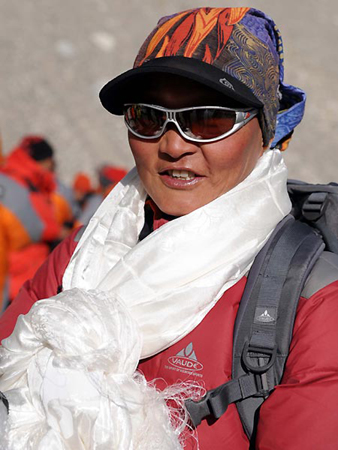The Chinese Mountaineering Team has been given a hero's welcome as they went down Mount Qomolangma to the 5,200-meter-high Base Camp after nine hours' trek on Friday.
Chinese mountaineers carry the Olympic flame lanterns to the Base Camp of Mt. Qomolangma, at the altitude of 5,200 meters, in southwest China's Tibet Autonomous Region on May 9, 2008. Chinese mountaineers relayed the 2008 Beijing Olympic torch to the top of Mt. Qomolangma on May 8.
The 36-member team, who impressed the world one day earlier by sending the Olympic flame atop the earth's summit, came back to the 6,500-meter-high camp late Thursday and headed for the Base Camp at about 10 a.m. Friday.
"It is important to have them back here all safely, and this also means that we have finished the job successfully," said Li Zhixin, chief of the Base Camp headquarters of the torch relay Qomolangma leg. "You should not interview me, talk to them (mountaineers). They are real heroes."
Chinese mountaineers display the Olympic flame lanterns after they returned to the Base Camp of Mt. Qomolangma, at the altitude of 5,200 meters, in southwest China's Tibet Autonomous Region on May 9, 2008.
A cheering crowd, mostly consisting of reporters and officials with the Chinese Mountaineering Association greeted the team, presenting each a hada, a traditional Tibetan scarf which means respect and loyalty. An official welcome ceremony will be held on Saturday.
The Olympic flame used for the torch relay Qomolangma leg was also brought back in the lantern before it is transported to Lhasa, capital of the Tibet Autonomous Region, on Saturday, waiting to join the main relay to be held in the capital in June.
Chinese mountaineers carrying Olympic flame lanterns safely return to the Base Camp of Mt. Qomolangma, at the altitude of 5,200 meters in southwest China's Tibet Autonomous Region on May 9, 2008. Chinese mountaineers relayed the 2008 Beijing Olympic torch to the top of Mt. Qomolangma on May 8.
"I feel so excited to carry the torch on top of the mountain," said team captain Wang Yongfeng, the second torch bearer in Thursday's grandiose relay. "It is a special connotation when you bring mountaineering and the Olympics together."
"I wish I could have shouted the slogan 'Light the passion, share the dream' during the relay, but when I held the torch I just felt a little bit worn-out," said the 45-year-old alpinist.
Gigi, a female Tibetan mountaineer who lost her husband, also an excellent mountaineer, in climbing, has never imagined that she could start the torch relay as the first runner.

Gyigyi, one of the two female climbers of the Chinese Mountaineering Team, smiles as she returns with her team to the Base Camp of Mt. Qomolangma, at the altitude of 5,200 meters, in southwest China's Tibet Autonomous Region on May 9, 2008.
"When I know that, I just could not sleep the night before, it is a thrilling experience. I told myself to be slow and hold the torch high, I feared that I might look clumsy," said the 39-year-old Gigi.
"I will never leave mountaineering. If one day I could not climb the mountains above 8,000 meters, I will try some shorter ones. After retirement, I will stay with the team, trying to be a coach, " she added.
The Beijing Olympics torch relay is the longest and most ambitious ever planned, traveling 137,000 kilometers across five continents in 130 days. One of the highlights in its global journey is the ascent of the world's highest mountain which spans Nepal and southwest China's Tibet Autonomous Region.
Wu Yingjie, executive vice chairman of Tibet Autonomous Region (L) greets Norbu Zhamdu (R) who lit the Olympic torch of the first torchbearer at the top of Mt. Qomolangma on May 8, at the Base Camp of Mt. Qomolangma in southwest China's Tibet Autonomous Region on May 9, 2008.
The peak is respected as "Mother Goddess" by the Tibetan minority. It is known to westerners as Mount Everest.
The Chinese Mountaineering Team has scaled Mount Qomolangma successfully for more than ten times since 1960.
According to a scientific measurement in 2005, the altitude of Mount Qomolangma is 8844.43 meters, 3.70 meters lower than the figure obtained in 1975.
(Xinhua News Agency May 10, 2008)